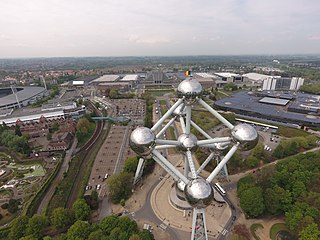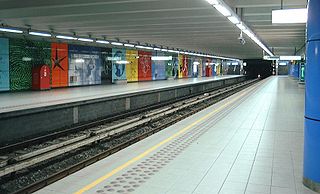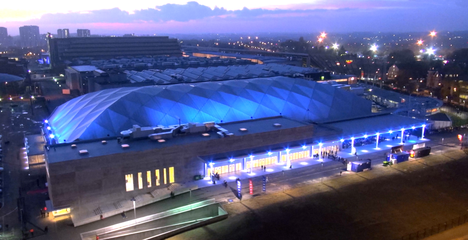
The Atomium is a landmark modernist building in Brussels, Belgium, originally constructed as the centrepiece of the 1958 Brussels World's Fair. Designed by the engineer André Waterkeyn and the architects André and Jean Polak as a tribute to scientific progress, as well as to symbolise Belgian engineering skills at the time, it is located on the Heysel/Heizel Plateau in Laeken, where the exhibition took place. It is the city's most popular tourist attraction, and serves as a museum, an art centre and a cultural destination.

The Heysel Plateau or Heysel Park, usually shortened to Heysel or Heizel, is a neighbourhood, park and exhibition space in Laeken, northern Brussels, Belgium, where the Brussels International Exposition of 1935 and the 1958 Brussels World's Fair took place.

Laeken or Laken is a residential suburb in the north-western part of the Brussels-Capital Region, Belgium. It belongs to the municipality of the City of Brussels and is mostly identified by the Belgian postal code: 1020. Prior to 1921, it was a separate municipality.

The Eurovision Song Contest 1987 was the 32nd edition of the annual Eurovision Song Contest. It took place in Brussels, Belgium, following the country's victory at the 1986 contest with the song "J'aime la vie" by Sandra Kim. Organised by the European Broadcasting Union (EBU) and host broadcaster Radio-télévision belge de la Communauté française (RTBF), the contest was held at the Centenary Palace on 9 May 1987 and hosted by French-Belgian singer Viktor Lazlo.

The Exposition Universelle of 1900, better known in English as the 1900 Paris Exposition, was a world's fair held in Paris, France, from 14 April to 12 November 1900, to celebrate the achievements of the past century and to accelerate development into the next. It was the sixth of ten major expositions held in the city between 1855 and 1937. It was held at the esplanade of Les Invalides, the Champ de Mars, the Trocadéro and at the banks of the Seine between them, with an additional section in the Bois de Vincennes, and it was visited by more than fifty million people. Many international congresses and other events were held within the framework of the exposition, including the 1900 Summer Olympics.

The City of Brussels is the largest municipality and historical centre of the Brussels-Capital Region, as well as the capital of the Flemish Region and Belgium. The City of Brussels is also the administrative centre of the European Union, as it hosts a number of principal EU institutions in its European Quarter.

Expo 58, also known as the 1958 Brussels World's Fair, was a world's fair held on the Heysel/Heizel Plateau in Brussels, Belgium, from 17 April to 19 October 1958. It was the first major world's fair registered under the Bureau International des Expositions (BIE) after World War II.

The Royal Museum for Central Africa (RMCA), communicating under the name AfricaMuseum since 2018, is an ethnography and natural history museum situated in Tervuren in Flemish Brabant, Belgium, just outside Brussels. It was originally built to showcase King Leopold II's Congo Free State in the International Exposition of 1897.

Heysel (French) or Heizel (Dutch) is a Brussels Metro station on line 6. It is located in Laeken, in the north-west of the City of Brussels, Belgium, and serves the Heysel/Heizel Plateau, famous for the World's Fairs of 1935 and 1958, the King Baudouin Stadium and the Atomium. The Bruparck entertainment park and the Centenary Palace, home to the Brussels Exhibition Centre, are also located nearby.

The Royal Palace of Brussels is the official palace of the King and Queen of the Belgians in the centre of the nation's capital, Brussels. However, it is not used as a royal residence, as the king and his family live in the Royal Palace of Laeken in northern Brussels. The website of the Belgian Monarchy describes the function of the Royal Palace as follows:
The Royal Palace is where His Majesty the King exercises his prerogatives as Head of State, grants audiences and deals with affairs of state. Apart from the offices of the King and the Queen, the Royal Palace houses the services of the Grand Marshal of the Court, the King's Head of Cabinet, the Head of the King's Military Household and the Intendant of the King's Civil List. The Royal Palace also includes the State Rooms where large receptions are held, as well as the apartments provided for foreign Heads of State during official visits.

The Centre for Fine Arts is a multi-purpose cultural venue in the Royal Quarter of Brussels, Belgium. It is often referred to as BOZAR in French or by its initials PSK in Dutch. This multidisciplinary space was designed to bring together a wide range of artistic events, whether music, visual arts, theatre, dance, literature, cinema or architecture.

Victor Bourgeois was a Belgian architect and urban planner, considered the greatest Belgian modernist architect.

The Brussels International Exposition of 1935 was a world's fair held between 27 April and 6 November 1935 on the Heysel/Heizel Plateau in Brussels, Belgium.

The Brussels International Exposition of 1897 was a world's fair held in Brussels, Belgium, from 10 May 1897 through 8 November 1897. There were 27 participating countries, and an estimated attendance of 7.8 million people.

The Brussels International Exposition of 1910 was a world's fair held in Brussels, Belgium, from 23 April to 1 November 1910. This was just thirteen years after Brussels' previous world's fair. It received 13 million visitors, covered 88 hectares and lost 100,000 Belgian francs.

Square – Brussels Convention Centre is the name of a convention centre in Brussels, Belgium. It is run by the GL Events group and situated in cultural and historic district of Brussels near the national and international institutions, overlooking the city from the hillside of the Mont des Arts.

The ING Arena is an indoor arena in Brussels, Belgium, that is part of the Brussels Expo complex. Located on the Heysel/Heizel Plateau in Laeken, it was originally built as the twelfth hall of the complex in 1989, but was extensively redesigned and reopened in its current form in September 2013. Until 14 September 2023, the arena was known as the Palais 12 in French or Paleis 12 in Dutch. It now hosts major events, such as concerts, conferences, entertainment shows and major sporting events for a maximum capacity of 15,000 people.

Design Museum Brussels is a museum located in the Heysel/Heizel Park in Brussels, Belgium, close to the Atomium. The space focuses on design works from the 20th and 21st centuries. It was formerly called the Art and Design Atomium Museum (ADAM) until 2020. The size of the museum is 5,000 m2 (54,000 sq ft) and it received about 126,000 visitors in 2019. Arnaud Bozzini is the museum's director.

The Art Deco movement of architecture and design appeared in Brussels, Belgium, immediately after World War I when the famed architect Victor Horta began designing the Centre for Fine Arts, and continued until the beginning of World War II in 1939. It took its name from the International Exposition of Modern Decorative and Industrial Arts held in Paris in 1925. At the end of World War II, Art Deco in Brussels faded to make way for the modernist and international architectural styles that would mark the postwar period.

The Africa Palace or Palace of Africa is a neoclassical palace in Tervuren in Flemish Brabant, Belgium, just outside Brussels. It was originally built in 1897 by order of King Leopold II to house the colonial section of the 1897 International Exposition. Nowadays, it is part of the Royal Museum for Central Africa (RMCA), and houses offices, storage rooms, classrooms and a reception hall. It was formerly called the Palace of the Colonies until 2018.



























